What is Customer Lifetime Value? 12 ways to increase CLTV for eCommerce

While running your eCommerce business, we are sure you look at many metrics to see if you are doing good – sales and profits being the most obvious. And if you have been in the business for longer, you might be tracking other metrics too that directly and indirectly impact your business.
But do you know there’s this one metric that many eCommerce business owners forget to look at? Customer’s Lifetime Value.
Ask yourself this question: Do you know how much sales a customer brings to your business during their lifespan?
The higher the chances you don’t!
And we get that. Unlike other eCommerce metrics, calculating customer lifetime value can be a little tricky and time-consuming – and lack of right guidance makes it tougher!
So to solve all of your questions about customer lifetime value (CLTV), we have come up with this in-depth guide which includes –
- The definition and meaning of customer lifetime value
- Key components of CLTV
- Customer lifetime value formula
- Benchmark of good customer lifetime value
- The importance of CLTV
- Factors that affect CLTV, and
- 12 solid ways to increase the customer’s lifetime value
So, let’s get started without any further delay!
What is Customer Lifetime Value in eCommerce?
Customer lifetime value in eCommerce is the total revenue a single customer can bring to your business during their lifespan. This also includes purchase frequency and the average order value of a customer.
Customer lifetime value is also known as CLTV, LTV, or CLV. If you carefully look at the definition of CLTV, you’ll see, that there are many components that come together to define the customer lifetime value formula.
If you don’t know what each terminology means, let’s have a quick look at them.
What are the Key Components of LTV?
As seen in the above definition of customer lifetime value, it combines three major components as mentioned below –
Purchase frequency (PF)
This defines how frequently customers buy products from your store. Is it once a month or three months or six months? Having this number clear in your mind helps you calculate CLTV.
Average order value (AOV)
As the name suggests, this metric defines what is the average amount a customer spends per order. The higher the AOV, the higher the profits per order.
Customer lifespan (CL)
Lastly, customer lifespan is the duration of customer association with your brand. For example, if you are targeting kids of three to five years old, your customer lifespan can be three to five years.
Depending on the products you sell, you can identify what would be the ideal and realistic lifespan of a customer.
So now that you know all the components of customer lifetime value, let’s have a look at calculating customer lifetime value.
How to calculate Customer Lifetime Value?
Follow this simple formula to calculate customer lifetime value –
Customer Lifetime Value = Average Order Value X Purchase Frequency X Average Customer Lifetime
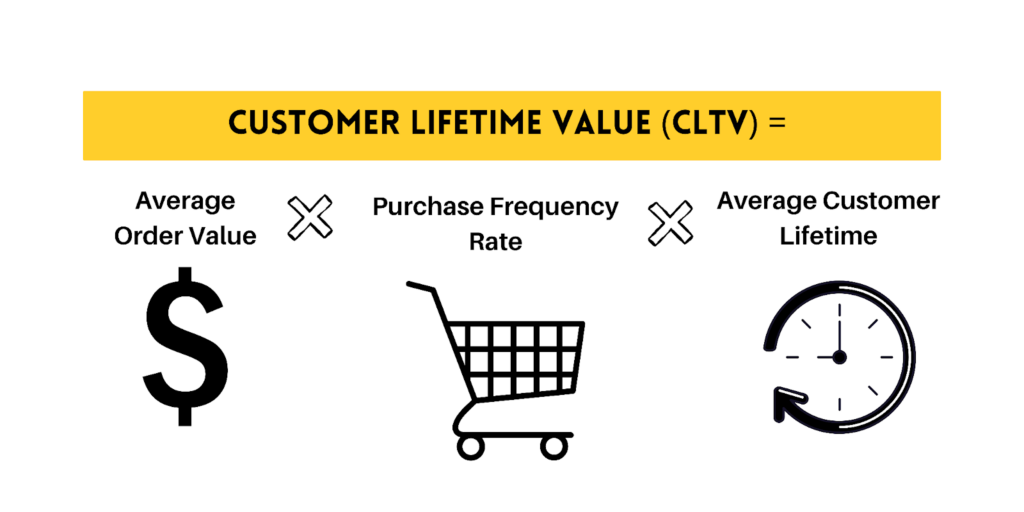
Now to get a better idea of this formula, let’s assume that you have a kids’ wear store with a total revenue of $100,000 a year. This includes 2,000 sellings to 1000 customers with a yearly churn rate of 50%. You can get this churn rate by either looking at your Shopify dashboard or calculating it manually (given below).
With this example, let’s have a quick look at each metric’s formula that leads to the CLTV number.
AOV = Total Revenue/ Number of Purchases
= 100000/2000
= $50
Purchase Frequency = Number of Purchases/Number of Customers
= 2,000/1000
= 2
Average Customer Lifetime = 1/(Yearly) Churn rate
= 1/0.50
= 2
PS: The formula to calculate churn rate is – Number of customers lost during the period/Total Number of Customers at the Start of Period ×100
Now let’s put all of these numbers in the customer lifetime formula to know your store’s actual customer lifetime value. Here’s how it would look –
CLTV = Average order value X purchase frequency X Average Customer Lifetime
= $50× 2× 2 = $200
You may now wonder if the value that you have got is good or not. Is it what everyone else has or do you need to increase your customer lifetime value?
Let’s have a look at the benchmark of good customer lifetime value in eCommerce.
What is a Good Customer Lifetime Value?
There’s no one-size-fits-all answer to this question. But to give you an idea, a good customer lifetime value is one where a CLV: CAC ratio of 3:1 means that for every dollar spent on acquiring a customer, the business generates three dollars in revenue.
Still, if you want to get a rough idea of what good customer lifetime value should look like in the eCommerce industry, we have got some data for you!
According to a study, the average CLTV in eCommerce is $168. The study surveyed multiple categories like apparel, Cannabidiol (CBD), coffee, cosmetics, high-performing sports clothing, meal deliveries, food products, pet stuff, supplements, and tea products.

After knowing the initial information about CTVL, it’s no wonder you are thinking why businesses focus so much on CLV. The simple reason is the role it plays in the finances and profitability of business in the long run.
To give you a better idea, we have mentioned all the points that convey the importance of CLV for a business.
Why Is CLV so Important?
There are many reasons why CLV matters when you want to play a long-term game. Here we have listed prominent points that convey the importance of CLTV.
Lets You Reduce Customer Acquisition & Retention Cost
Let’s say, you are running a campaign to acquire new customers and you want to know if the cost per acquisition is good or not. When you have a clear idea of your CLTV, you can easily evaluate if your CPA is good or not.
In case your CLTV is $200 and your CPA is $60, you are making $140 per customer, making it profitable for your company.
Other than getting insight into customer acquiring costs, an LTV number also lets you decide if the amount you are spending to retain a customer is worth it or not.
For example, if you are making $140 net per customer, you can allocate $20 per year per customer to retain your customers for longer – giving you $120 as profit from each customer.
Moreover, CLV also helps you get a better understanding of your customer segment and their buying behavior. This in return helps you develop effective marketing strategies that reduce CAC and retention costs even further.
Lets you Allocate Resources Effectively
Once you have a better idea and insight about how much you can spend on CAC and customer retention, you can plan and allocate all your resources accordingly.
So let’s say if your LTV is $200, you can spend 25% ($50) of it as CAC and 15% ($30) for retention – making you $120 as your gross margin to cover other costs and profit.
And when you allocate the resources effectively, it also results in healthy cash flow as it prevents burning huge amounts of unfruitful activities – bringing in steady revenue for your store.
Allows You Long-Term Planning

So now that you have got insights about your customer acquisition and retention cost, and know how to allocate your resources effectively, you can focus on the long-term planning of your business.
Plannings like growing your business overseas, developing a new category or range of products to sell, and hiring new employees without creating a big hole in your pockets – all of these are possible when you know your customer’s lifetime value and expected revenue over a period of time.
Plus, when you know the buying frequency of your customers along with profits, it lets you manage your product inventory in an optimum way.
Directly Impacts the Profitability in the Long Run
Last but not least, the customer’s lifetime value has a direct impact on your profitability in the long run. So when you know your CLTV, you can decide if you need to improve it and what strategies will help you optimize your profit margins.
Additionally, when you have a clear idea about each aspect of your LTV, you can optimize the aspects that are costing you the most – be it about reducing CAC or optimizing the offers and discounts you give.
Also, CLV gives you an idea of the targeted customer segment and scope of improvement in your products and services based on their buying behavior. Having these key insights lets you remain profitable.
As you now know the importance of customer lifetime value, let’s understand what are the factors that affect CTLV.
What are the Factors that Affect CLTV?
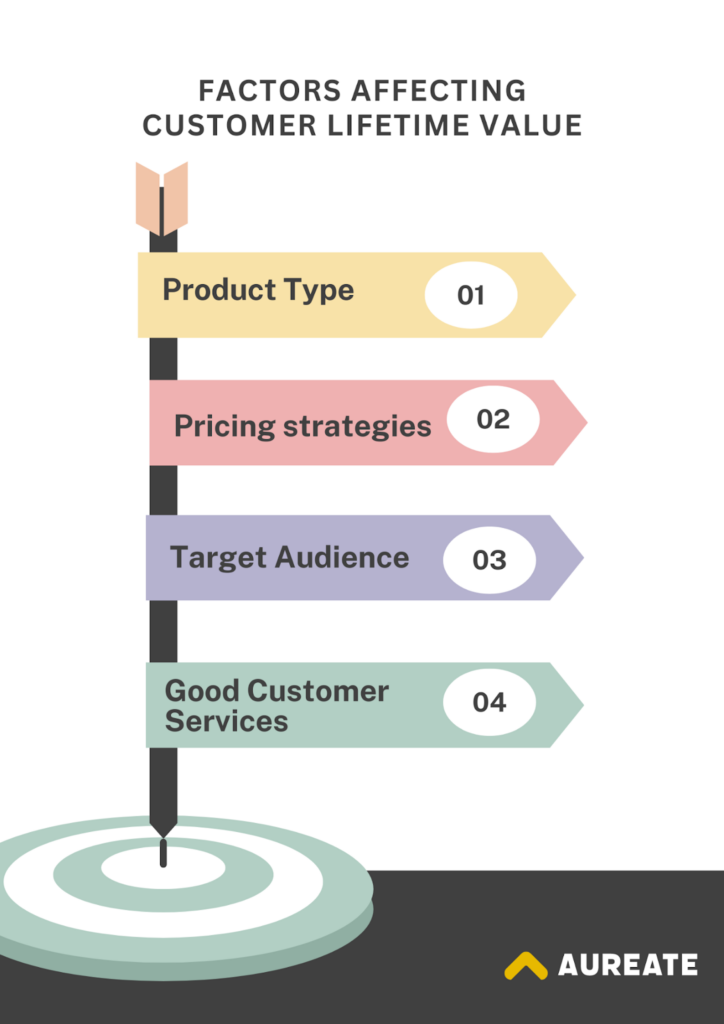
Product Type
The first and foremost factor that decides your store’s CLTV is the type of products you sell. If you are selling high-end goods, your CLTV would be higher than the ones who are targeting low to average order value.
Moreover, whether your products are seasonal or evergreen play an important role in formulating customer lifetime value.
Pricing strategies
Other than the product type, the pricing also plays a huge role in CLTV.
Are you selling it at higher prices than your competitors? Or are you selling it at cheap prices? Can your products be sold through a subscription model? Or are they a kind of nature that can be sold in bulk? What is the average order value?
If your pricing is premium, your CLTV can be higher than your competitors but if you are targeting mass, you may need to sell more people (and multiple times) to achieve higher CLTV.
Target Audience
Next, whom you are selling matters as it defines how much they are willing to pay, how frequently they will buy, and what will be their spending habits. So if you are a direct-to-customer (DTC) brand, your LTV can be lesser than a brand that deals in the same segment as you but with a B2B model.
Quality of Customer Services
Let’s assume that you have cracked it all – product, pricing, and target segment. But if your customer service is not up to the mark – it can hamper your LTV. You need to make sure that your customer feels welcomed, heard, and supported at every stage of their journey so that they keep coming back to your business while referring your products to others – improving your CLTV.
After getting quite a lot of details about customer lifetime value – let’s learn how to increase it with effective and practical strategies.
How to Increase Customer Lifetime Value?
Depending on the industry you are in, there are many ways to increase customer lifetime value. Here are some guaranteed ways to improve customer lifetime value –
- Have Solid Products
- Offer Next Level Customer Support
- Create Nostalgia with Education and Inspiration
- Maximize Sales Opportunities
- Build Community and Customer Loyalty Programs
- Listen to Your Customers Carefully
- Provide a Smooth Shopping Experience
- Increase Brand Recall with Retargeting Ads
- Initiate Strategic Brand Collaboration
- Leveraging Customer Data and Insights
- Increase Pricing Strategically
Let’s have a look at each of these strategies in brief!
1. Offer High-Quality Products
If your eCommerce business is the building and CLVs are stories, the products are the foundation of that building. The quality of your products decides how tall and strong a building can be built.
When your products consistently meet or exceed customer expectations, it will naturally help you build the trust and loyalty of your customers. And great products are the best brand ambassadors which results in customer repeat purchases, contributing to a higher customer lifetime value (CLTV).
So all the techniques we are going to share with you as we move forward will work only if your product has great quality to flaunt.
When you have solid products in your portfolio, they become a brand ambassador and salesman of your business that encourages repeat orders – increasing customer lifetime value.
Moreover, make sure that your packaging is good because if you give gold in a plastic bag, your overall brand image will get hampered – affecting CLTV in the long run.
2. Offer Next Level Customer Support
Other than great products, working on customer satisfaction is the next best strategy you can use to increase customer lifetime value as 42% of the companies follow the same method.
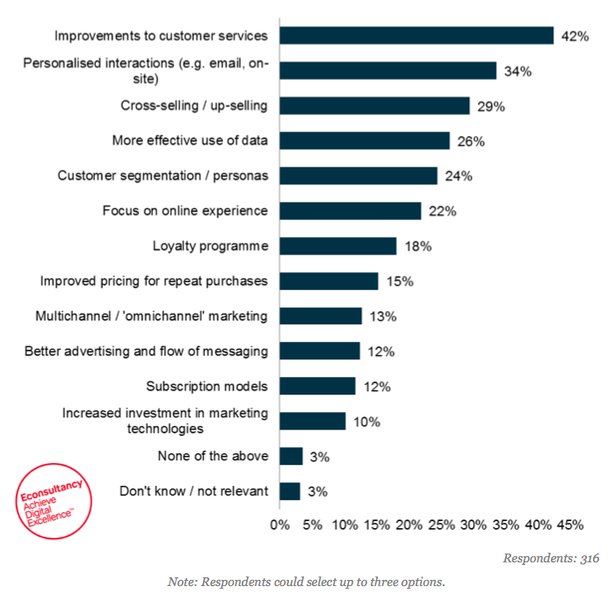
This is true especially when you are in a D2C model as you need to cater to a huge set of customers and a bigger pool of customers means you need to have a strong team who can handle it all.
When customer support solves your customers’ problems, they can pitch them further relevant products if required. And even if they don’t sell anything, solving their problems quickly promotes improved brand loyalty – helping you retain customers for longer periods.
To make this possible, provide good enough training to your staff about product knowledge, soft-skill training, and emotional intelligence to resolve each customer’s queries at the earliest possible.
Remember, the more delay in solving a problem, the more frustration a customer feels – making them avoid buying from you in the future. You can also be available on multiple channels (including social media) so customers don’t struggle to find you.
And when you are on other social media channels, you can create long-lasting relationships with your customers in a way that leads to increased customer lifetime value.
But how exactly?
By creating nostalgia with educational and inspirational content (let’s discuss next).
3. Create Nostalgia with Education and Inspiration
What is seen is sold, right? Getting in front of your target audience more often means you are on their mind all the time.
And creating content that educates and inspires your audience is the best way to increase brand visibility while nurturing lasting relationships and customer loyalty.
You can create nostalgic and educational content by focusing on the bigger purpose of your brand than just products and sales, and educating your audience about how your products solve bigger problems.
Nike is a great example of motivating their target audience through their inspirational content and this in return helps them to be on top of their target audience all the time.
For example, Jannik Sinner became the first Italian man to win the U.S. Open and Nike took this opportunity to celebrate the moment to get visibility from their target audience – sports enthusiasts.
And when Nike is being seen by their target audience, it helps them increase their customer lifetime value.

So, the lesson is clear, be active on digital platforms and double down on content strategies that are generating you better revenue to increase customer lifetime value.
However, being visible and reaching more audience doesn’t directly translate into increased customer lifetime value. You also need to maximize sales opportunities to achieve your goals.
Let’s explore how you can do that!
4. Maximize Sales Opportunities
If you don’t knock at the door at the right time, you may lose the sales opportunity that is just one step away. All the strategies mentioned above will definitely make your brand desirable but sometimes you need to go the extra mile and offer an additional layer of motivation so that your customers buy from you.
Here are some ways to maximize sales opportunities to increase customer lifetime value –
Encourage Frequent Orders
This is the most effective strategy you can leverage to increase your CLTV, especially if your customer lifespan is short.
Think of deals like offering 15% or 20% off if they make the next purchase within a month. (For example, bathing products) Also, send them timely notifications to remind them about the offer and purchase.
Upselling and Cross-selling
Another way you can maximize sales opportunities is by upselling and cross-selling your products – either on product pages or at the checkout page.
For example, product A costs $50, and product B costs $50 but if they buy both products together, they get product C costing $25 for free!
Other than this, you can also create a bundle of products that people can buy together at lower prices – which helps you increase average order value, ultimately increasing customer lifetime value.
This method is quite useful when a customer’s lifespan is long but purchase frequency is less.
PS: If you are a fashion store owner, you can’t miss reading more ways to increase average order value.
Implement Subscription Models:
Lastly, if you are selling products that people need to buy again and again (personal care and grooming products), you can encourage customers to opt for the subscription model by offering better discounts.

Bite Toothpaste Bits is a great example of offering a subscription model to promote zero-waste lifestyles by reducing plastic pollution. In 2018, one of their videos went viral where they conveyed their message of sustainability and subscription and it made them crazy sales of $200,000 compared to $6,000 the previous year.
With this initiative, they not only boosted their immediate sales but also attracted a new audience who are concerned about the environment, helping them focus on the subscription model to increase their customer lifetime value.
As a result of this, their market size is projected to reach USD 12 Billion by 2030 from USD 5 Billion in 2023.
If you have noticed, Bite has been able to achieve these results because they targeted a community of eco-conscious people.
So how can you do the same to increase your customer lifetime value? Let’s find out!
5. Build Community and Customer Loyalty Programs
Having a community of people who share the same values and vision as your brand is the best way to make them loyal to you. And the higher the loyalty, the better customer lifetime value!
But the question here becomes that if you are not a big brand (yet), how can you tap into the power of community?
Follow these strategies to build a strong community of loyal customer base –
Encourage and promote user-generated content
Everybody likes to get the spotlight and when you make your users the brand ambassadors, it gives them a sense of belongingness and value.
You can ask customers to share their photos/videos with your products to get featured on your social media pages. And not just the products, you can also promote inspiring and emotional stories your customers have to share.
Remember, when you connect with them on an emotional level, it directly influences their purchase decisions!
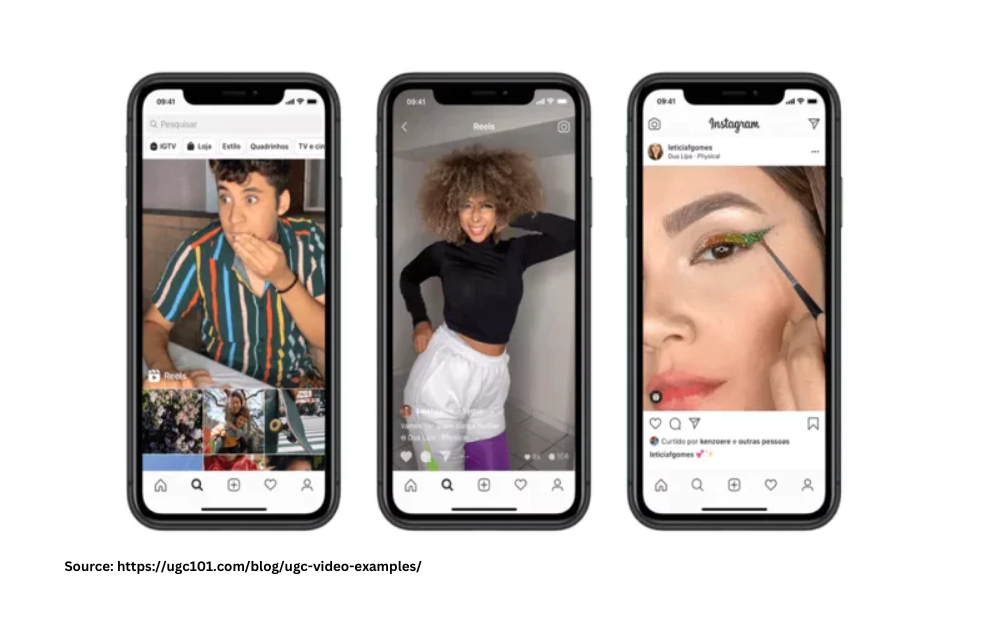
Run Meaningful Newsletters and WhatsApp Campaigns
Other than social media, you can build a community of loyal customers by communicating with them directly through newsletters and WhatsApp campaigns to increase customer lifetime value.
For example, if your brand has taken a new initiative, you can communicate that through emails and WhatsApp to let your customers know about it! What’s in for them? Offer them deals to buy products related to that initiative that you’ve taken!
Moreover, you can share behind-the-scenes, employee spotlights, and the impact you are creating in the world with these campaigns. For example, Meow Meow Tweet, a vegan skincare brand owned by Asians and Queer, shows how they are making an impact in the world by collaborating with meaningful projects.
These initiatives help them build a strong community of like-minded people and increase their customer base.

Host Offline events based on shared interest
Lastly, you can also host and conduct offline events to make an even bigger impact and talk directly with your customers. Find common ground (taking the example of Bite – eco-consciousness) and host/conduct events that talk about bigger causes to convey the bigger picture.

As you can see, Bite Toothpaste Bits never fails to convey its messaging of sustainability and eco-consciousness.
When people see that you are contributing to a greater good, they are more likely to join you in your mission and become loyal customers of your brand!
6. Listen to Your Customers Carefully
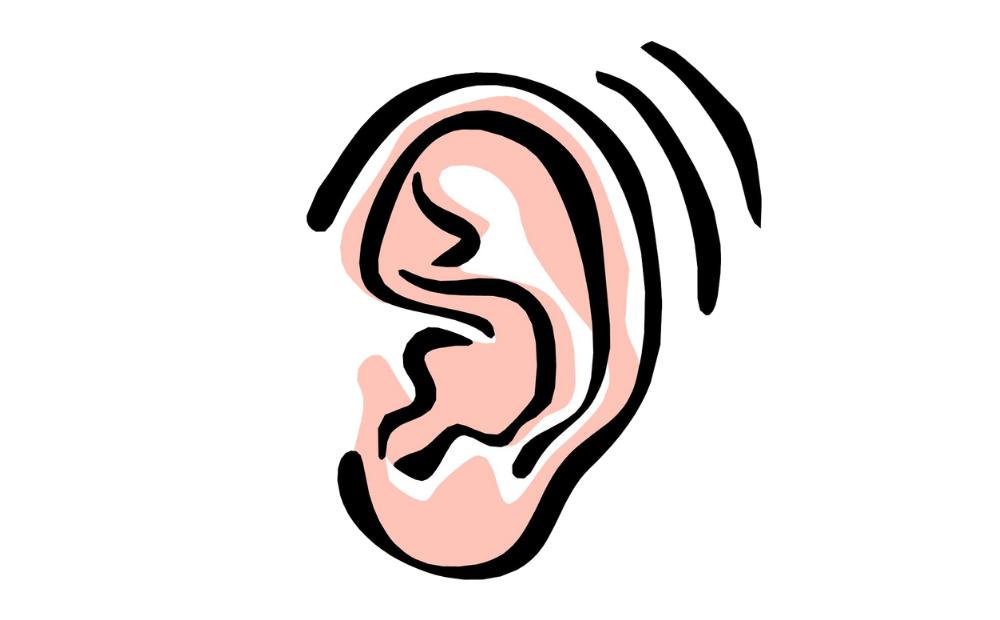
Your customer feedback holds the answer to all the business challenges you have – including how to increase customer lifetime value!
By asking your customers the right questions, you can get to know what are the real reasons behind their behavior – be it buying more or not repeating the order ever after.
Though there are many ways to collect feedback, we highly recommend calling and talking with your customers as it gives you a window to ask more questions and understand underlying issues your business can solve to increase customer lifetime value.
Other than calls, you can also ask for feedback through forms on websites, emails, and WhatsApp to collect more and more data. You can also convert your feedback forms into easy-to-use and free QR codes and share them post-purchase through emails, whatsapp, etc.
While analyzing this data, you will come across issues that you may have skipped your sight, like the scope of improvement in your products, policies, and overall shopping experience.
Shopping experience – that’s a whole topic to cover – bringing us to our next point.
7. Provide a Smooth Shopping Experience
Did you know that 75% of customers are willing to spend more to buy from companies that give them a good customer experience? This customer experience starts from the moment they land on your website!
And if you can’t provide them with a good shopping experience, you are breaking the foundation of increasing customer lifetime value.
So here are some quick tips to provide a smooth shopping experience to your customers –
- Have a user-friendly store
Being an eCommerce business, your store becomes the first point of contact with your customers. But if your store is not user-friendly and customers need to struggle a lot to find the relevant categories, products, and CTA buttons, they will never return to your store ever after.
We would recommend having a conversion-focused design for your store so that you not only increase initial conversions but also make a strong foundation to apply the above-given strategies to increase customer lifetime value.
- Leverage Social Commerce
Other than your own website, you should also make your products available on social commerce to increase its visibility and make it easier for customers to buy with one click.
For example, if a customer has bought a product from your website earlier, and now sees it on a social platform – they can buy without visiting your website – as shown below in the example.
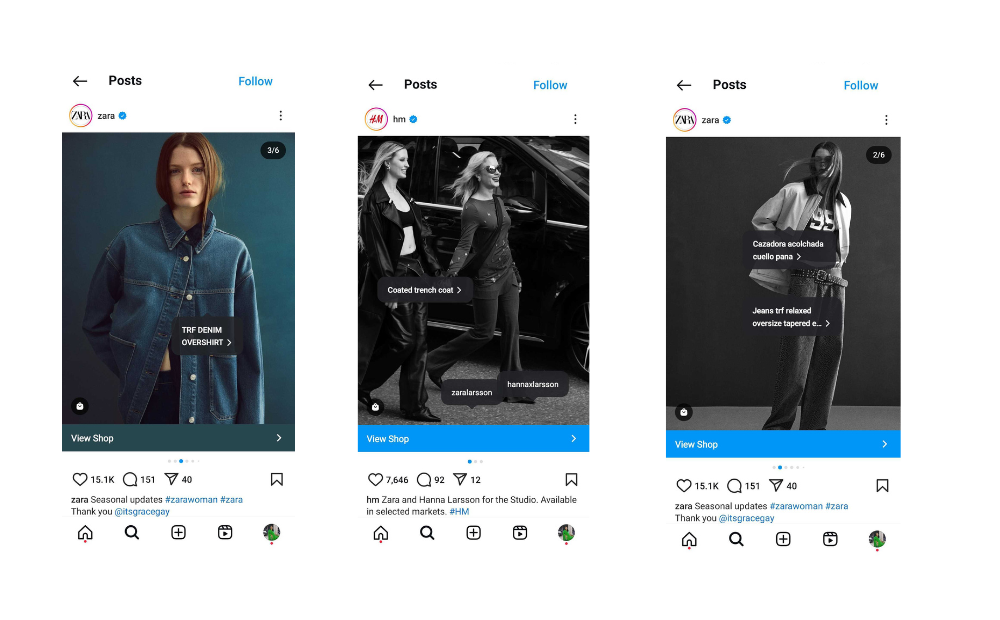
When you have your products listed on social commerce, it will help you increase the number of sales and thus increase customer lifetime value.
Make Returns Easy –
Another strategy you can use to enhance the customer shopping experience is by making returns easy. It may sound counterproductive at first but this makes it easier for customers to buy your products without hesitation.
The good thing here is that if they like your products, they will buy your products without any hesitation the next time – helping you increase customer lifetime value.
Get Creative with Post-Purchase Communication
Many marketers forget that customer relationships don’t end once you sell them a product but it actually begins at that time.
And you can make this relationship memorable by getting creative about how you talk to your customers. Starting from giving them updates about a successful payment to shipping, delivery, and future deals and offers – when you set yourself apart from others, you give them a lasting shopping experience.
In the given below example, you can see how they have captured the attention of their customers not only with a clear copy but attention-catching visuals that make them different from others.
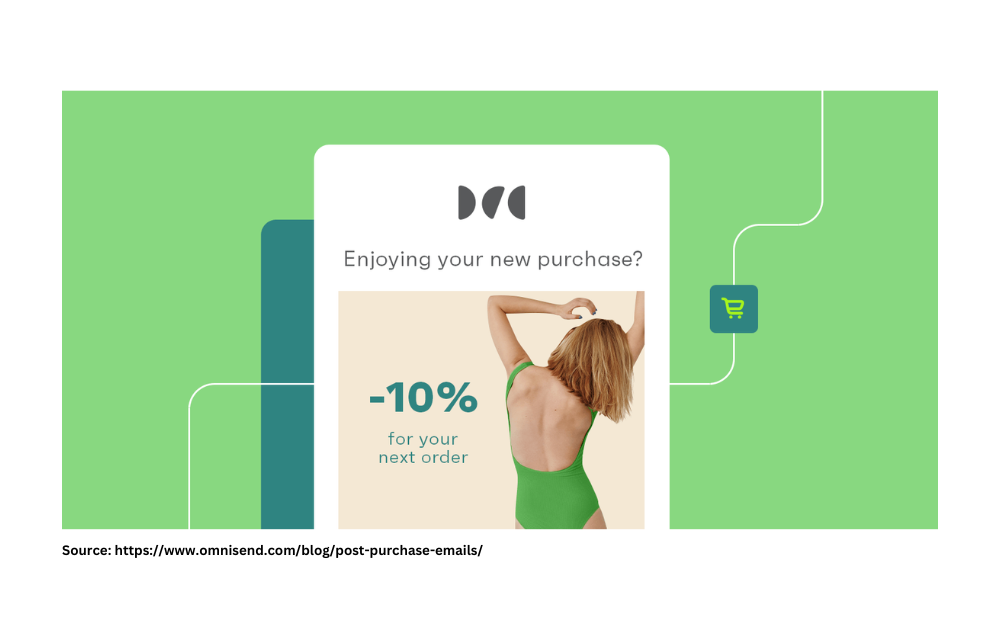
However, with increasing competition, your customers may forget you in the crowd of new emerging brands, hampering your brand recall. And when the brand recall is poor, you lose customers over a period of time.
To solve this problem and maintain a good CLV ratio, it becomes important to run brand recall campaigns with retargeting ads.
8. Increase Brand Recall with Retargeting Ads
Your customers see hundreds if not thousands of ads every day and in this chaos, they can easily forget the brands they have purchased earlier.
The retargeting works well for both new and repeat customers. So, let’s say a new customer has visited your website, and when they see your ads on social media, it reminds them of their visit, resulting in higher chances of conversion.
For repeat customers, you can use brand recall ads to show different categories and products of your store for them to buy the next time.
Brand recall ads are the best way to be on top of your customers’ minds and increase conversions.
When a customer sees your ad, again and again, your brand elevates from an unaware brand to top of a mind brand – helping you increase sales and customer lifetime value.

Other than paid ads, there’s one more way to increase your brand awareness and positioning – and that’s through strategic brand collaborations.
9. Initiate Strategic Brand Collaborations
When you want to increase your customer lifetime value in a competitive market, you need to take a different approach to collaboration rather than cutting the throats of other brands.
Collaborating with other brands helps both of you to tap into extended markets with a win-win situation. So for example, if you sell high-quality fashion clothes, you can collaborate with a brand that sells accessories or other complementary products to provide an exclusive experience to your customers.
Other than collaborating with other brands, you can also think of collaborating with popular influencers who share the same space as you and have a big impact on the industry.
One such famous example of a popular brand coming together for collaboration is Kylie Cosmetics and Kendall Jenner. This combination of game-changing beauty products and a global fashion icon was quite successful and it helped Kylie to acquire new customers while increasing the lifetime value of existing customers.

10. Leveraging Customer Data and Insights
We all know the rule of 80/20 and it applies to increasing customer lifetime value too. It means that 20% of your customers bring in 80% of the revenue.
But how do you identify these 20%?
By following the RFM model. It stands for Recency, Frequency, and Monetary. You can analyze this data using a scoring system to accurately determine your most valuable customers. You can refer to the below image to understand the concept of recency, frequency, and monetary.
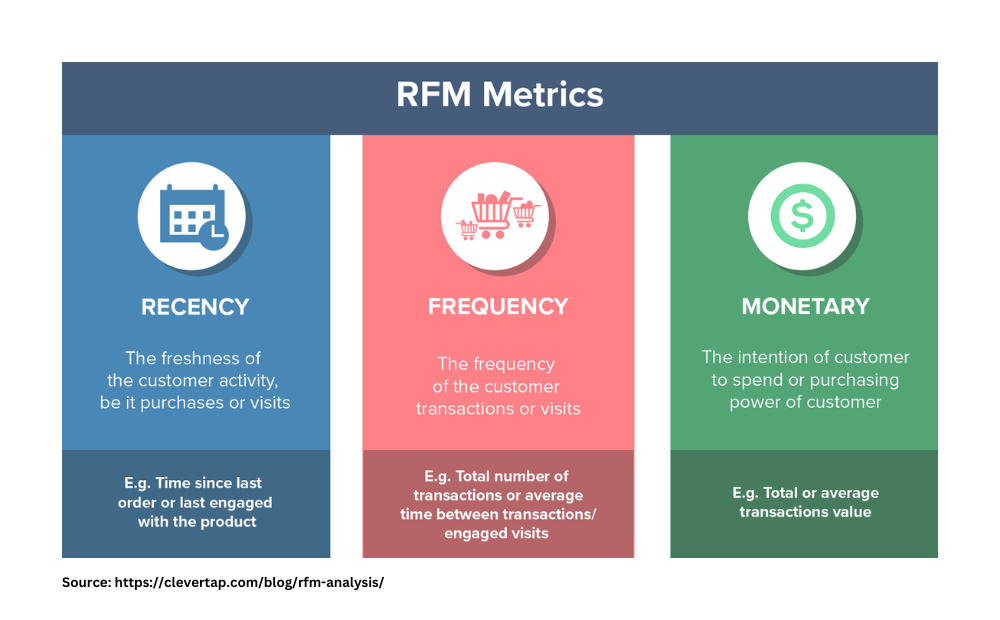
Once you have filtered out the most valuable customers, you can apply strategies like offering better discounts, personalized up-selling and cross-selling recommendations, and different pricing strategies to check which method is working the best.
Improve Your LTV with Expert Strategies and Support
We hope with all the knowledge that you have gained about how to increase customer lifetime value, you can start with the ones that look feasible to you at the moment and move forward with other strategies as you scale.
However, doing all of these by yourself can be tough sometimes, and in such scenarios, it’s best to partner with an agency that knows in and out of eCommerce.
A well-experienced team of professionals can help you with your eCommerce marketing in a full-fledged way while bringing you good results.
If you would like to know what value you can get by onboarding an agency, feel free to get in touch with our team while having a quick look at the work we have done for our clients.
FAQs Related to Customer Lifetime Value
What is CLV used for?
Customer Lifetime Value (CLV) is used to estimate the total revenue a business can expect from a customer over the entire duration of their relationship.
What is the goal of CLV?
The goal of CLV is to measure the financial impact of marketing and sales activities while identifying the high-value customer segments.
What is a good CLV ratio?
A good CLV to CAC ratio is 3:1. It means for every $1 spent on acquiring a customer, you should get $3 as customer lifetime value.
What is the 80/20 rule in CLV?
In CLV, the 80/20 rule indicates that 80% of the business revenue comes from 20% of the customers. By focusing more on this 20%, you can generate better results for your business.
Is CLV a good KPI?
Yes, CLV is a good KPI to measure business growth, predict profitability, decide the right customer acquisition budget, and set the right goals for the future.






Post a Comment
Got a question? Have a feedback? Please feel free to leave your ideas, opinions, and questions in the comments section of our post! ❤️